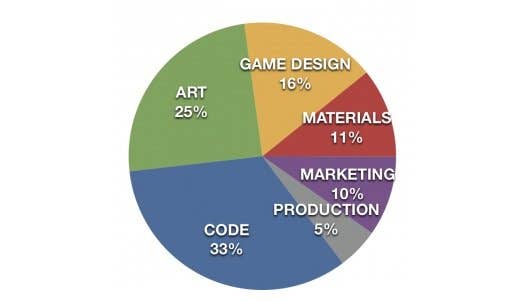Indie Project Budgets
Broken Rules' Martin Pichlmair discusses the maths behind its recent public funding for three new projects
Each week we feature the best content from #AltDevBlogADay, a blog site on which developers write daily about things that they find interesting. This week it's the turn of co-owner of Broken Rules Martin Pichlmair, who looks at funding for independent games.
I've recently stumbled across the numbers behind Angry Birds. Reportedly, producing the game cost $140,000 whereas the revenue generated approaches $70m making Angry Birds one of the most successful media franchises in history. Another game that was in the news was No Time To Explain. The game clocks in at $16,649 on Kickstarter at the time of writing. Indie games are produced with budgets between those two numbers (and less).
For a AAA-developer, even a budget of $140,000 would be a joke. Yet for an iPhone project, this is an immense pile of money. The average budget for iPhone software can be assumed as $35,000. Even with a budget that low, you can not expect to generate enough revenue to recoup your investment. In fact, it is not a sane economic decision to invest $140k in a project for a platform where the average return is as low as on the iPhone. According to this analysis, the average sales of a number of surveyed games were 11,625 units, or 44 copies per day. However, 56 per cent of the those games sold less than 10,000 units. What lessons can be learned from this state of affairs?
We're working on a series of three games at the moment. While I cannot talk about the content of those games yet, I would love to take this opportunity to talk about our budget. We've recently received public funding for this project. Remember, we're based in Europe. In order to acquire that funds we had to submit a detailed project and budget plan for the duration of the project, which runs until early 2013 in our case. Each game has a budget of around $100,000 for the initial release and a further budget of around $75,000 for ports and sustained support. How did I end up with these numbers? I've had an enlightening conversation with Martin de Ronde from Vanguard Games (and formerly from Guerilla Games) and after that I knew what to do. Martin was kind enough to share his thoughts on development costs and his advice was: Either go for $100,000 or invest more than half a million. Since the latter was not an option for us, we decided to design the project so that it fits in the first category.

Our budget is spread between all kinds of development tasks, from coding and game design to marketing. Additionally, there are material costs for dev kits and there's a travelling budget. The following pie chart (left) shows the distribution between those tasks. The "Code" task is a bit misleading because it includes all programming as well as gameplay-scripting and other game design tasks like controls tuning. Also, 80 per cent of the costs summed up as "Materials" are marketing costs. Still, our marketing costs are exceptionally low and our coding pretty dominant. If I had had this chart at hand when I planned the project I would have skewed the numbers a bit to give marketing a bigger role. Still, most of our marketing is community building, which is a) cheap and b) not in the project plan.
I would not advise to take this template and apply it to any project. The reason why the coding piece of the pie is so large is that we're currently building our own tech, as you know.
Compared to other indie games that have published their development budgets, we are on the cheap side. Braid – a showcase in indie marketing as well as game design – cost $180,000 to develop. World of Goo, another indie darling, had a budget of $120,000. Both are in the "forbidden zone" mentioned above, as is Angry Birds. We are aiming at three games of the size and scope of these examples and hope to achieve the same level of game design and polish.
In sum, I think it was a brilliant idea of Rovio to invest $140,000 on an iPhone game. There are only a handful of games of this scope on that platform and most of them were very successful (e.g. Rage, Infinity Blade, World of Goo). The tide of no-budget games drowns most low-to-normal budget outings. Rovio went with a publisher – Chillingo – and allocated the time and talent needed to bring the game into a shape that reduced the risk of investment significantly. In other words: investing $20,000 in a downloadable game is gambling. With a fitting budget and the right team, you can reduce your risk. I'm sure there's a business term for this.
Take another grain of salt and apply it to my personal advice, which is:
- It looks like $100k to $140k is a suitable budget for a downloadable indie game.
- It is wise to acquire additional money for sustained support and porting, although you might only need it if you strike gold, anyway.
- There are more articles about sales numbers than about development budgets online.
- Of course, the most important thing is that your budget fits to your game.
